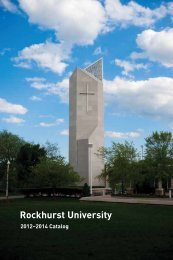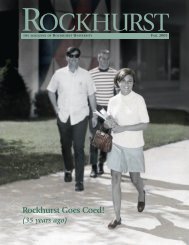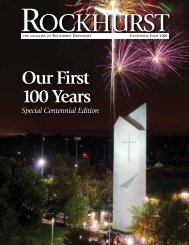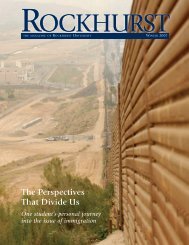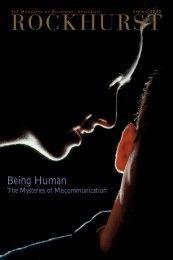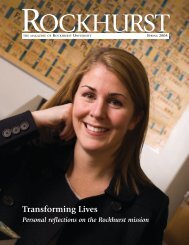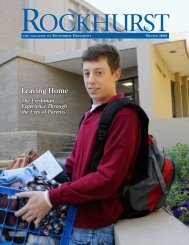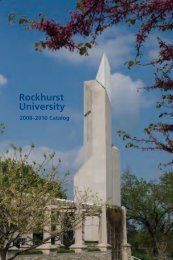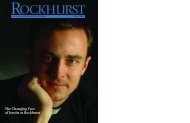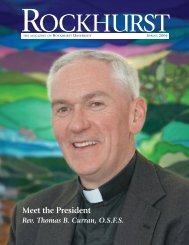in the Jesuit Tradition - Rockhurst University
in the Jesuit Tradition - Rockhurst University
in the Jesuit Tradition - Rockhurst University
You also want an ePaper? Increase the reach of your titles
YUMPU automatically turns print PDFs into web optimized ePapers that Google loves.
We’re Watch<strong>in</strong>gIn April 1945, a reluctant Harry Trumangalloped through <strong>the</strong> basement of <strong>the</strong> U.S.Capitol build<strong>in</strong>g on his way to <strong>the</strong> Cab<strong>in</strong>etRoom where he was to be sworn <strong>in</strong> as <strong>the</strong>33rd president of <strong>the</strong> United States. In stunnedstoicism, he opened <strong>the</strong> door to <strong>the</strong> room to seeFrankl<strong>in</strong> Roosevelt’s Cab<strong>in</strong>et look back at him <strong>in</strong>silence. Truman stepped forward, placed his lefthand on <strong>the</strong> Bible and raised his right. Afterrepeat<strong>in</strong>g <strong>the</strong> oath of office, Truman raised <strong>the</strong>Bible firmly to his lips and kissed its cover as ifwithdraw<strong>in</strong>g all of its <strong>in</strong>spiration.Despite be<strong>in</strong>g captured on film for newsreel,few of <strong>the</strong> general public witnessed <strong>the</strong> event.What a beautiful display of passion and commitment<strong>the</strong>y missed. What an awesome taskTruman faced. If only <strong>the</strong> newsreel footagecould have been seen <strong>in</strong> real time so hiscommunication advisers and political consultantscould have capitalized on and spun <strong>the</strong> image ofTruman reach<strong>in</strong>g deep <strong>in</strong>side himself to accept<strong>the</strong> magnitude of his task.Communication advisers? Consultants?Sp<strong>in</strong>?Not <strong>in</strong> Harry Truman’s day. Later, dur<strong>in</strong>ghis 1948 campaign, estimates suggested <strong>the</strong>rewere only about 150,000 television sets operat<strong>in</strong>g<strong>in</strong> <strong>the</strong> United States. Truman delivered hisnom<strong>in</strong>ation acceptance speech hours from primetime, at 2:15 a.m., <strong>in</strong> a hot, smoky Philadelphiaconvention center. Television was not a factor<strong>in</strong> how Truman led <strong>the</strong> country and tried toconv<strong>in</strong>ce it to elect him. Now, television and <strong>the</strong>image of leadership it presents are among <strong>the</strong>primary concerns of American political figures,most notably presidents.Television is, <strong>in</strong> terms of a communicationchannel, still a very new medium. Televisionorig<strong>in</strong>ated dur<strong>in</strong>g <strong>the</strong> lifetime of many ofour country’s citizens. Television cont<strong>in</strong>ues toadapt to chang<strong>in</strong>g technology and to push <strong>the</strong>envelope of content. Programs of <strong>the</strong> ’60s wereunlike those of <strong>the</strong> ’50s, programs of <strong>the</strong> ’70sunlike those of <strong>the</strong> ’60s and, certa<strong>in</strong>ly, contemporarytelevision is unlike anyth<strong>in</strong>g we’ve seenbefore. To suggest that <strong>the</strong> power of televisionhas peaked <strong>in</strong> any way is to ignore its enormous<strong>in</strong>fluence (and potential). In short, we are stillexperiment<strong>in</strong>g with how television affects peopleon Presidential LeadershipPhoto courtesy of John Fitzgerald Kennedy Library.





